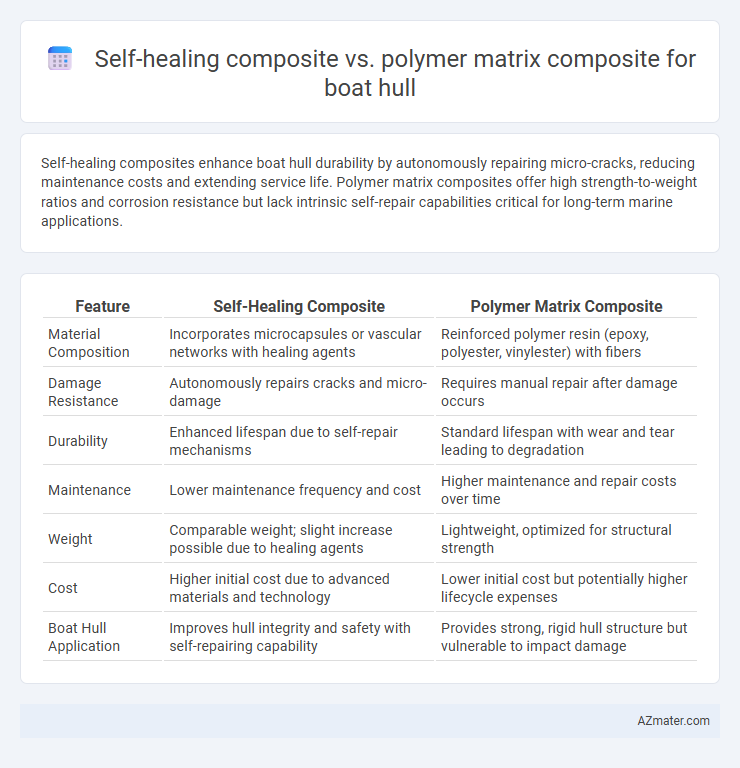Self-healing composites enhance boat hull durability by autonomously repairing micro-cracks, reducing maintenance costs and extending service life. Polymer matrix composites offer high strength-to-weight ratios and corrosion resistance but lack intrinsic self-repair capabilities critical for long-term marine applications.
Table of Comparison
| Feature | Self-Healing Composite | Polymer Matrix Composite |
|---|---|---|
| Material Composition | Incorporates microcapsules or vascular networks with healing agents | Reinforced polymer resin (epoxy, polyester, vinylester) with fibers |
| Damage Resistance | Autonomously repairs cracks and micro-damage | Requires manual repair after damage occurs |
| Durability | Enhanced lifespan due to self-repair mechanisms | Standard lifespan with wear and tear leading to degradation |
| Maintenance | Lower maintenance frequency and cost | Higher maintenance and repair costs over time |
| Weight | Comparable weight; slight increase possible due to healing agents | Lightweight, optimized for structural strength |
| Cost | Higher initial cost due to advanced materials and technology | Lower initial cost but potentially higher lifecycle expenses |
| Boat Hull Application | Improves hull integrity and safety with self-repairing capability | Provides strong, rigid hull structure but vulnerable to impact damage |
Introduction to Boat Hull Materials
Boat hull materials primarily require high strength, durability, and resistance to water damage, making Polymer Matrix Composites (PMCs) a common choice due to their lightweight properties and corrosion resistance. Self-healing composites introduce advanced functionality by incorporating microcapsules or vascular networks that autonomously repair micro-cracks, enhancing the hull's longevity and reducing maintenance costs. Compared to traditional PMCs, self-healing composites offer improved safety and sustainability for marine vessels by minimizing structural degradation over time.
Overview of Polymer Matrix Composites (PMC)
Polymer Matrix Composites (PMC) consist of a polymer resin reinforced with fibers such as glass, carbon, or aramid, providing high strength-to-weight ratios ideal for boat hull construction. PMCs offer excellent corrosion resistance, impact strength, and tailored mechanical properties, making them preferred materials in marine applications. Their versatility allows customization for durability and performance, though they typically lack the intrinsic damage repair capabilities found in self-healing composites.
Fundamentals of Self-Healing Composites
Self-healing composites incorporate microcapsules or vascular networks containing healing agents that autonomously repair damage in polymer matrix composites, enhancing durability and extending service life of boat hulls. The fundamental mechanism involves the release of these agents upon matrix cracking, which polymerize and restore structural integrity without human intervention. Compared to traditional polymer matrix composites, self-healing composites significantly reduce maintenance costs and improve safety by mitigating microcracks and delamination in marine environments.
Mechanical Properties Comparison
Self-healing composites for boat hulls enhance durability by autonomously repairing microcracks, significantly improving impact resistance and extending service life compared to traditional polymer matrix composites. Polymer matrix composites provide high stiffness and strength but lack the ability to recover after damage, leading to progressive weakening under marine stressors. The mechanical advantage of self-healing composites lies in their increased fracture toughness and fatigue resistance, making them superior for long-term structural integrity in marine environments.
Durability and Longevity
Self-healing composites for boat hulls significantly enhance durability by autonomously repairing microcracks, reducing structural degradation over time compared to traditional polymer matrix composites (PMCs), which rely on external maintenance. The intrinsic self-healing mechanism in these composites extends hull longevity by preventing crack propagation and water ingress, thereby maintaining material integrity and performance in harsh marine environments. In contrast, PMCs, while lightweight and corrosion-resistant, are more susceptible to irreversible damage from impacts and fatigue, requiring frequent repairs to sustain durability.
Maintenance and Repairability
Self-healing composites for boat hulls significantly reduce maintenance costs by automatically repairing micro-cracks and damage, enhancing longevity and safety. Polymer matrix composites require manual inspection and repair, often leading to more frequent maintenance and higher downtime. The self-healing capability ensures quicker recovery from impact damage, minimizing labor and material expenses compared to conventional polymer matrix composites.
Cost Analysis and Economic Viability
Self-healing composites for boat hulls offer enhanced durability by autonomously repairing damage, which can reduce long-term maintenance costs compared to traditional polymer matrix composites (PMCs). Initial manufacturing expenses for self-healing composites are significantly higher due to the complexity of embedded healing agents and advanced materials, posing economic challenges for large-scale production. Despite the upfront investment, the overall lifecycle cost benefits and reduced downtime position self-healing composites as economically viable for high-performance marine applications where maintenance costs are critical.
Environmental Impact and Sustainability
Self-healing composites for boat hulls reduce environmental impact by extending service life and minimizing material waste compared to traditional polymer matrix composites, which often require complete replacement upon damage. These advanced materials incorporate microcapsules or vascular networks that autonomously repair cracks, decreasing maintenance frequency and resource consumption. Polymer matrix composites, while strong and lightweight, typically rely on non-biodegradable resins and contribute to marine pollution through microplastic shedding and end-of-life disposal challenges.
Real-world Applications in Marine Industry
Self-healing composites integrated into boat hulls enhance durability by autonomously repairing micro-cracks caused by mechanical stress and corrosion, significantly extending service life and reducing maintenance costs in marine environments. Polymer matrix composites (PMCs), while offering high strength-to-weight ratios and corrosion resistance, lack inherent self-repair capabilities, making them more prone to cumulative damage over time when exposed to harsh oceanic conditions. The marine industry increasingly adopts self-healing composites for critical applications such as hull reinforcements and underwater structures to improve safety, lower lifecycle expenses, and ensure structural integrity in saltwater exposure and impact scenarios.
Future Trends and Innovations
Self-healing composites for boat hulls represent a cutting-edge innovation, incorporating microcapsules or vascular networks that autonomously repair cracks and damage, significantly extending hull lifespan and reducing maintenance costs. Future trends emphasize enhancing the efficiency of self-healing mechanisms through nanotechnology and smart sensors integrated into polymer matrix composites, enabling real-time damage detection and automated repair processes. Advances in bio-based polymers and sustainable materials are driving the development of eco-friendly composite hulls with improved mechanical performance and self-healing capabilities, aligning with the marine industry's growing focus on environmental responsibility.

Infographic: Self-healing composite vs Polymer matrix composite for Boat hull
 azmater.com
azmater.com